Abstract
1. The phasic stretch reflex in biceps brachii has been recorded in 372 normal subjects aged from 31 weeks gestation to 55 years. The stimulus used was a brief mechanical pulse delivered by a hand-held electromagnetic vibrator and the response was measured in the surface electromyogram. 2. The threshold for eliciting the reflex was low in the newborn and increased over the first 6 years to values corresponding to those of adults. 3. On the basis of timing it is concluded that the phasic stretch reflex has a monosynaptic component at all ages. 4. The surface electromyogram was also recorded in triceps brachii, pectoralis major, deltoid and hypothenar muscles. In some subjects evoking the phasic stretch reflex in biceps brachii resulted in short latency responses in these muscles, a phenomenon termed radiated response. 5. The probability of occurrence of radiated responses and their magnitudes were greatest at birth and decreased over 2-4 years. 6. Experiments were performed to determine how far mechanical transmission of the stimulus to biceps through the tissues of the arm might account for the radiated responses in the other muscles studied. It was concluded that the responses observed in triceps brachii, pectoralis major, deltoid and hypothenar muscles, following vibration of the biceps tendon, are primarily due to the radiation of the activity carried in biceps muscle afferents to the alpha-motoneurones of the respective muscles. 7. On the basis of timing it is concluded that in subjects below 2 years the radiated responses in the muscles studied have a monosynaptic component.
Full text
PDF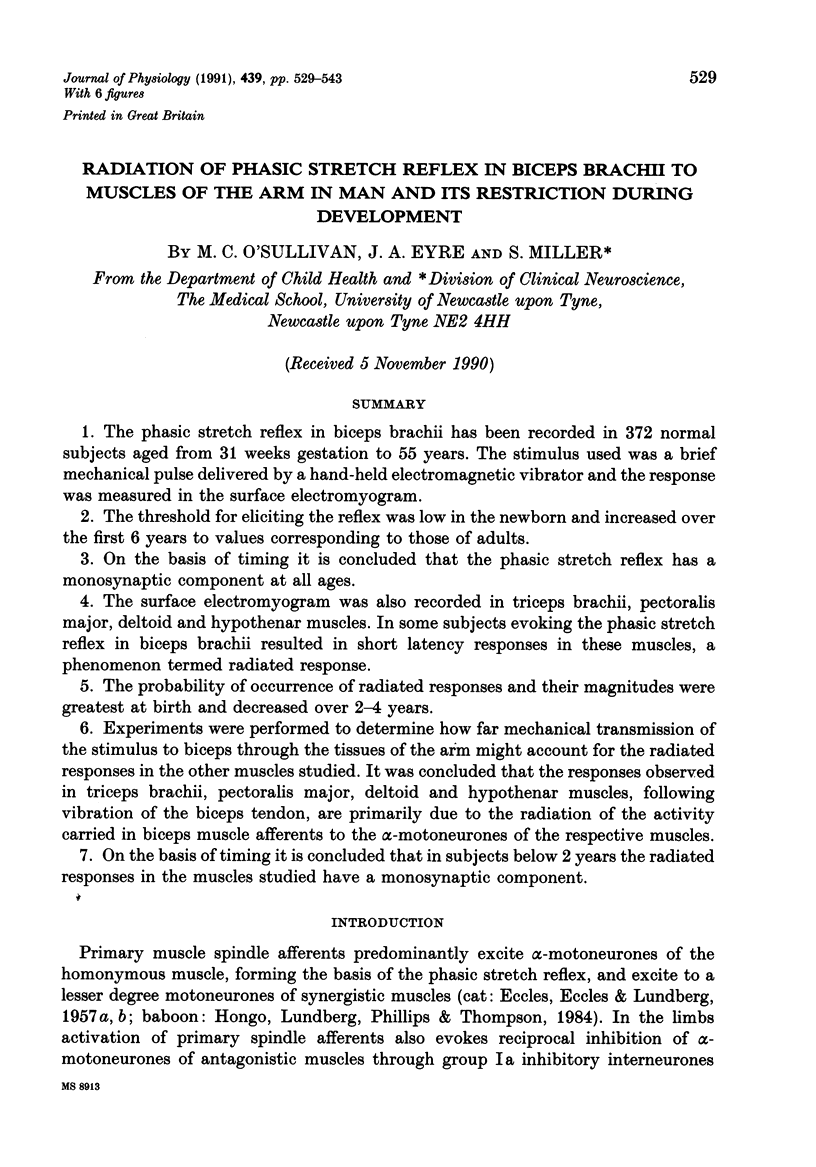
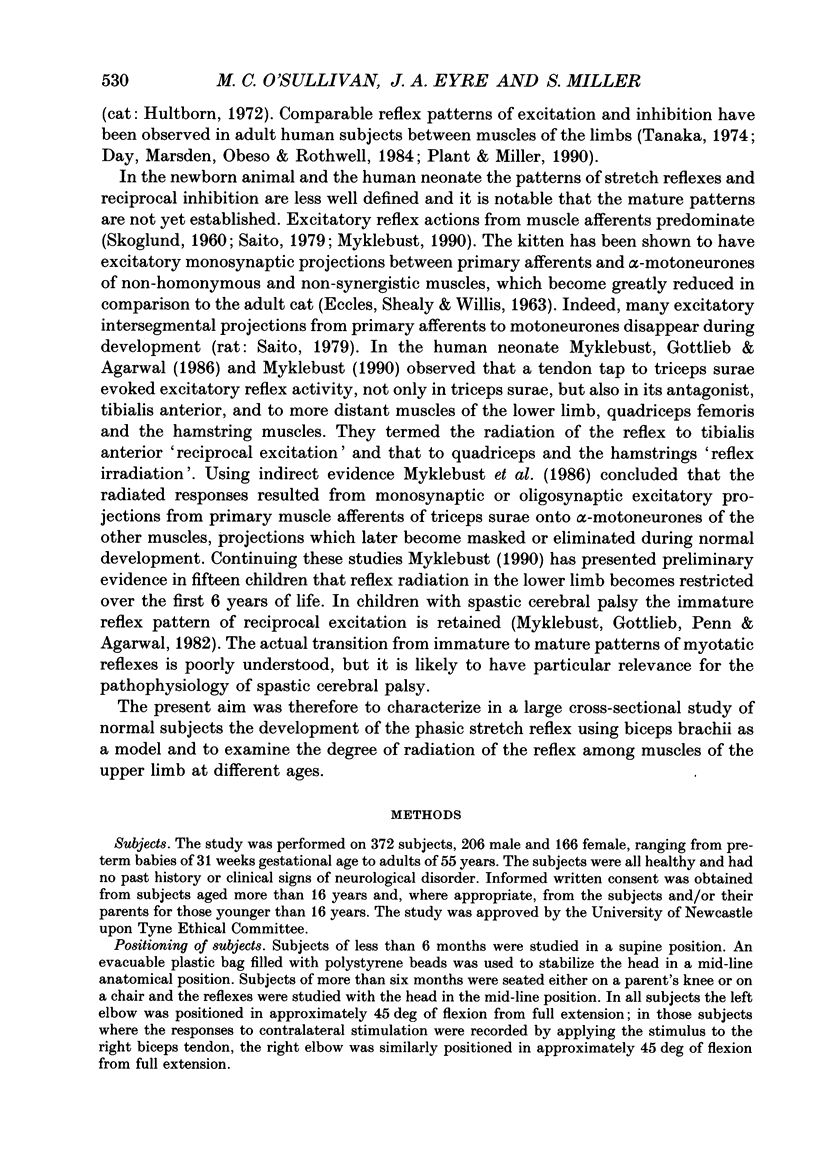
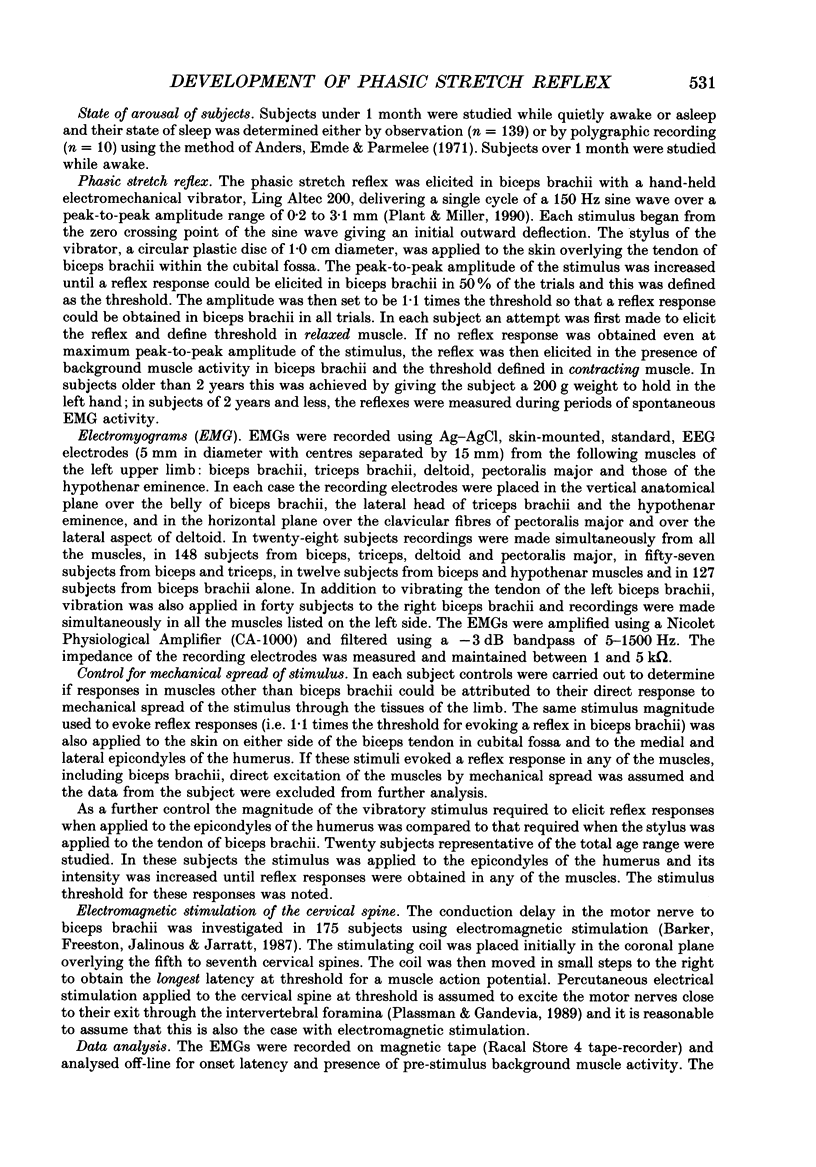
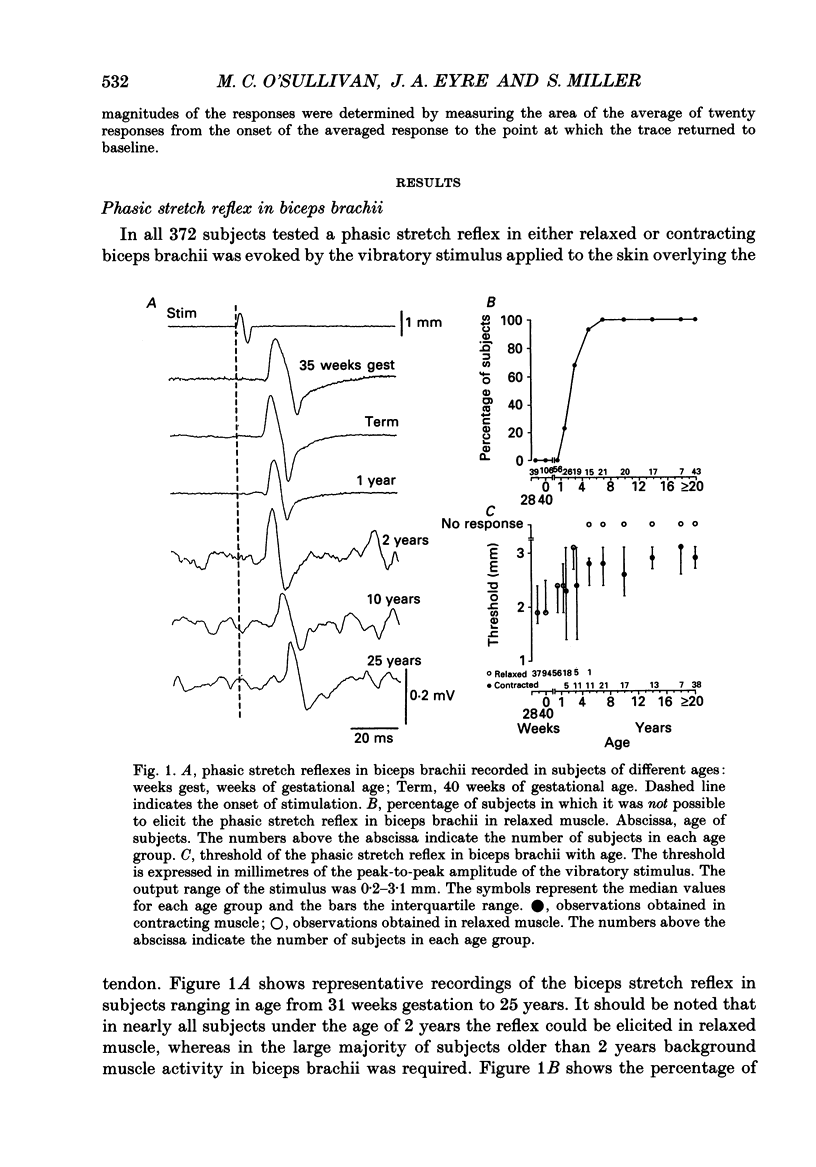
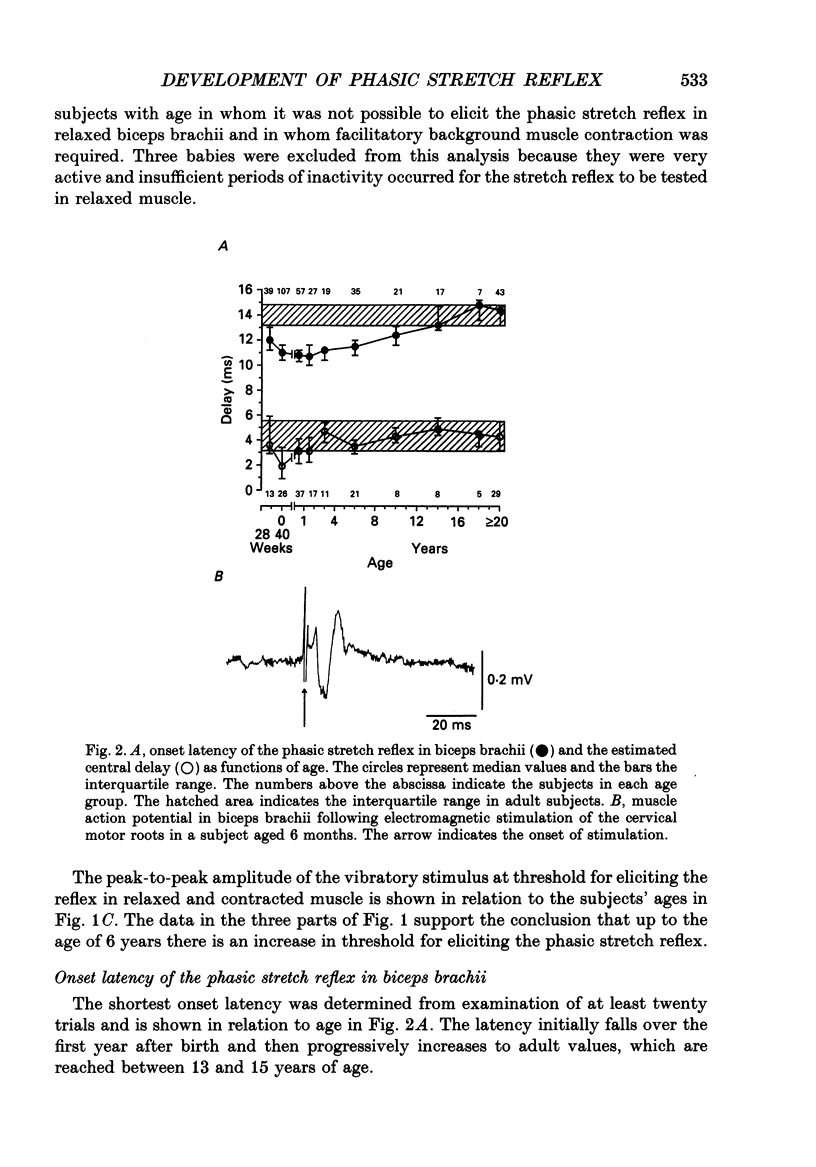
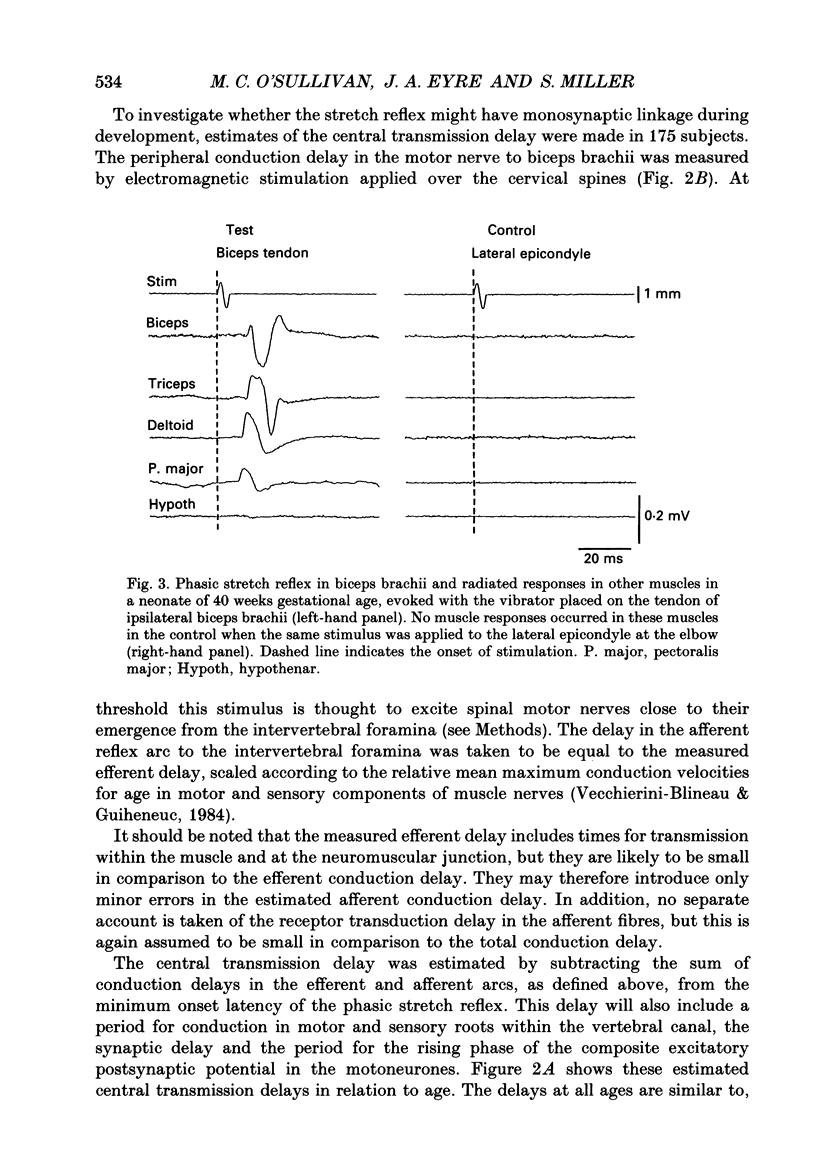
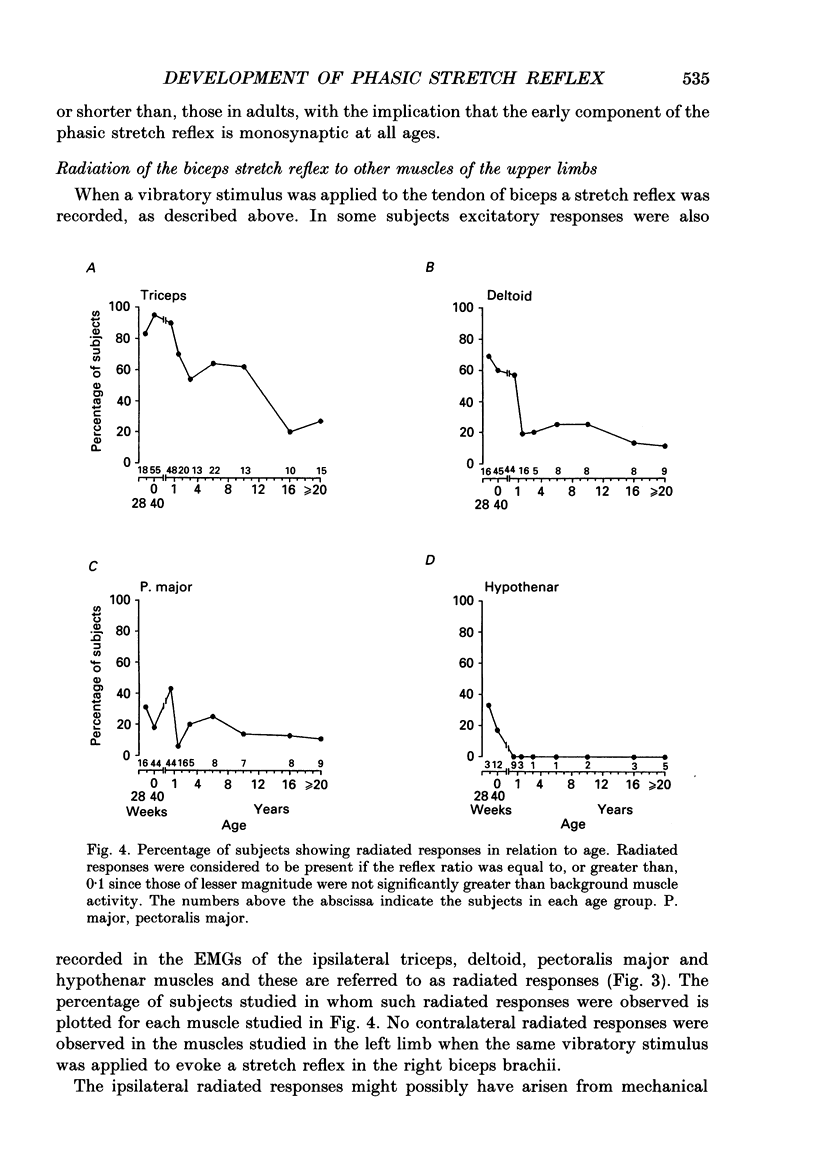
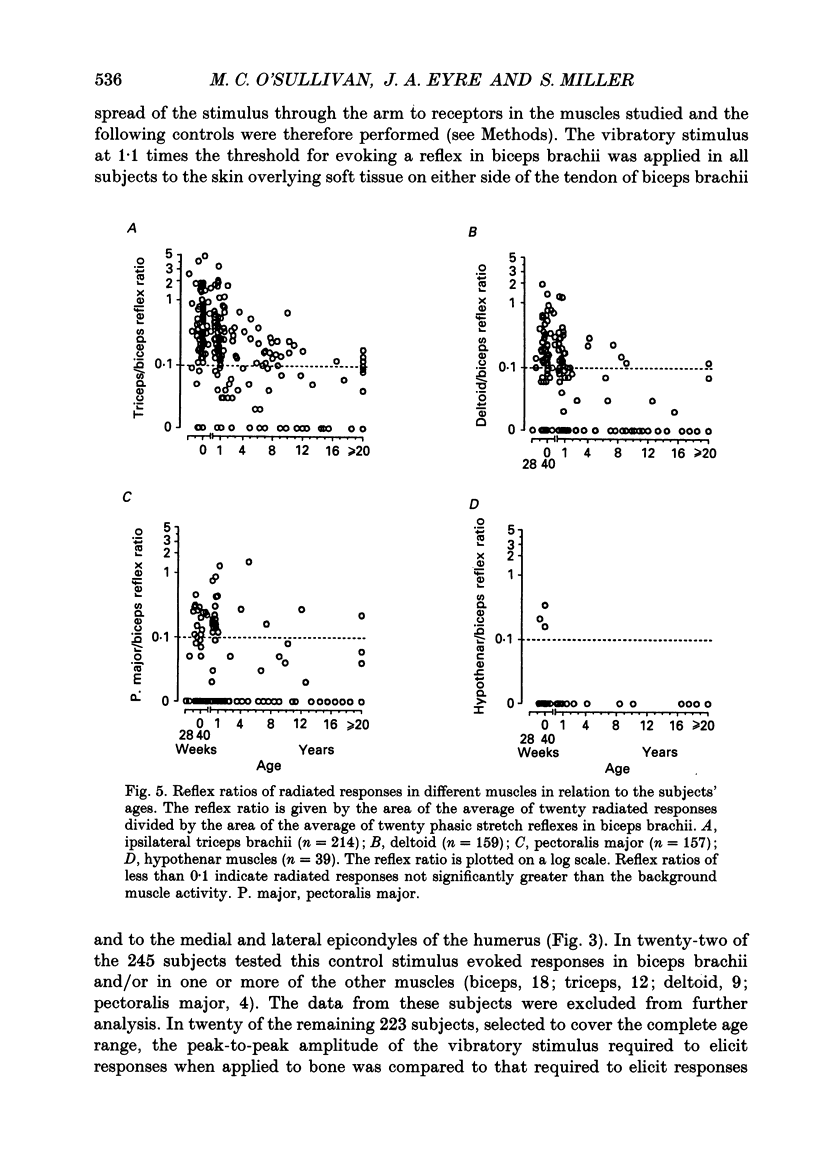
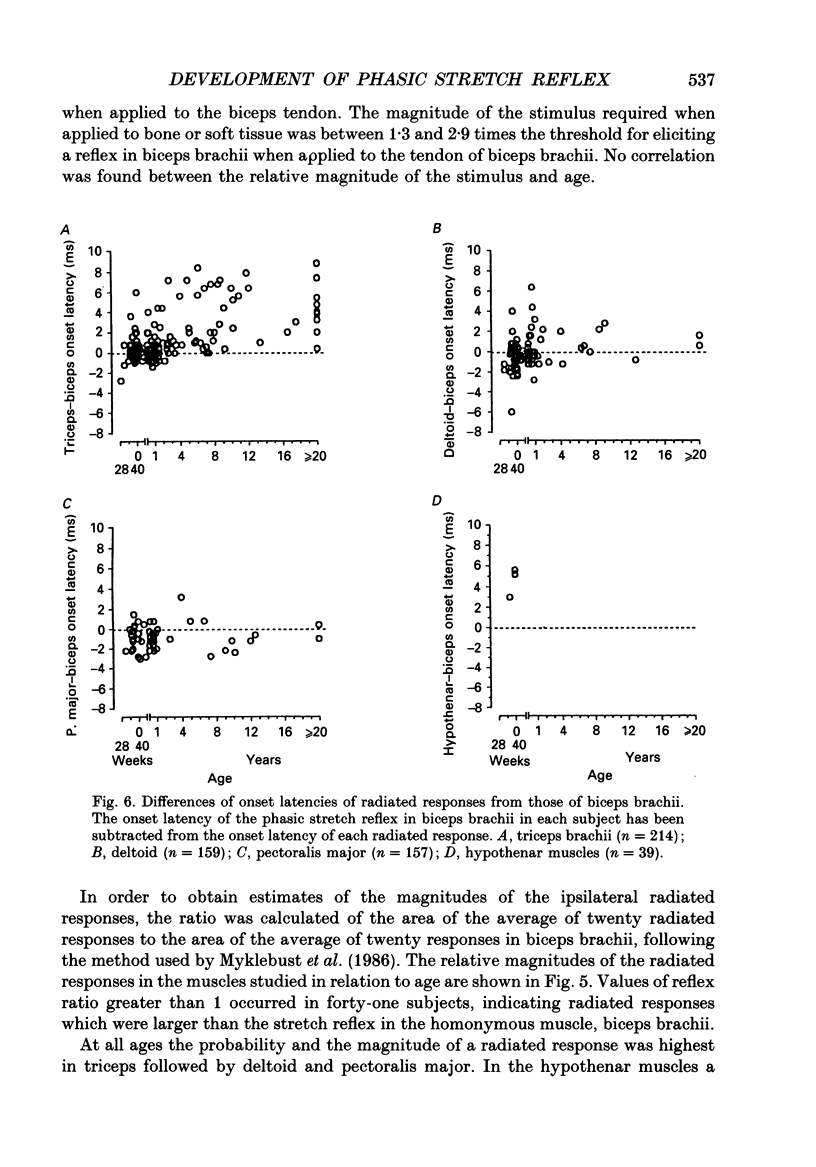
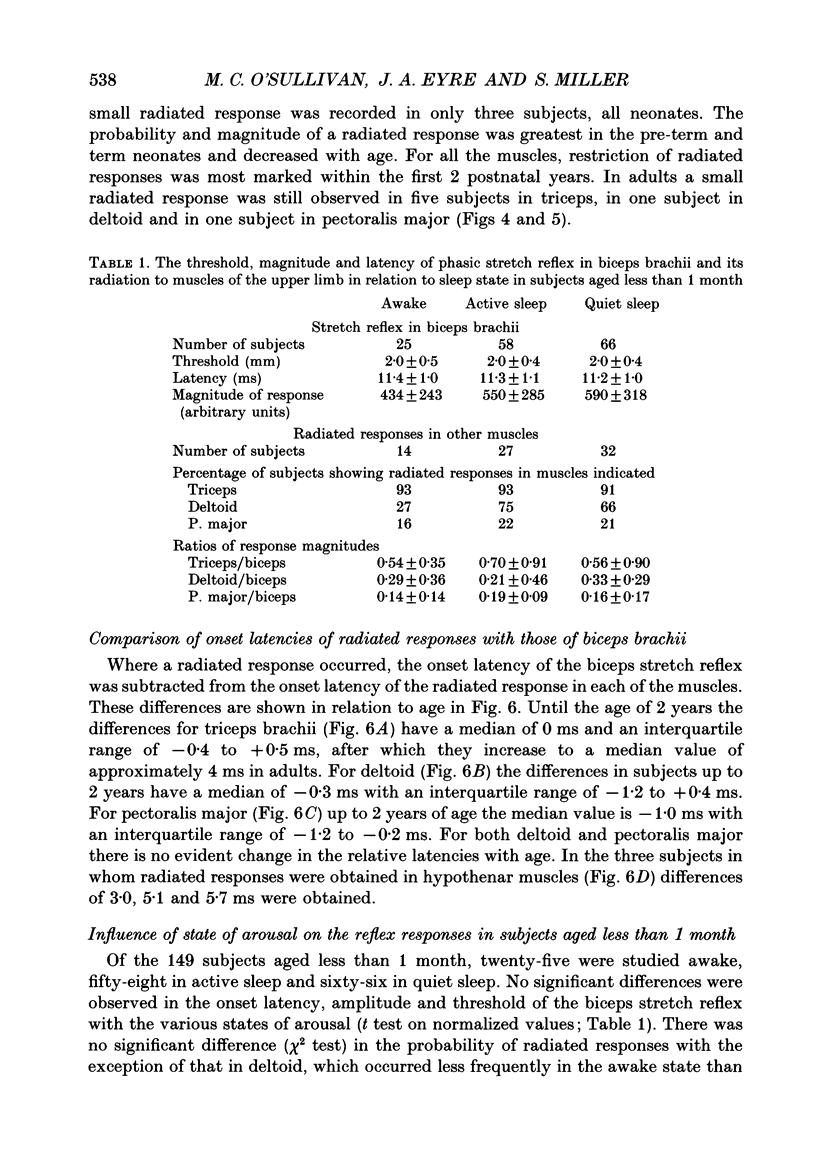
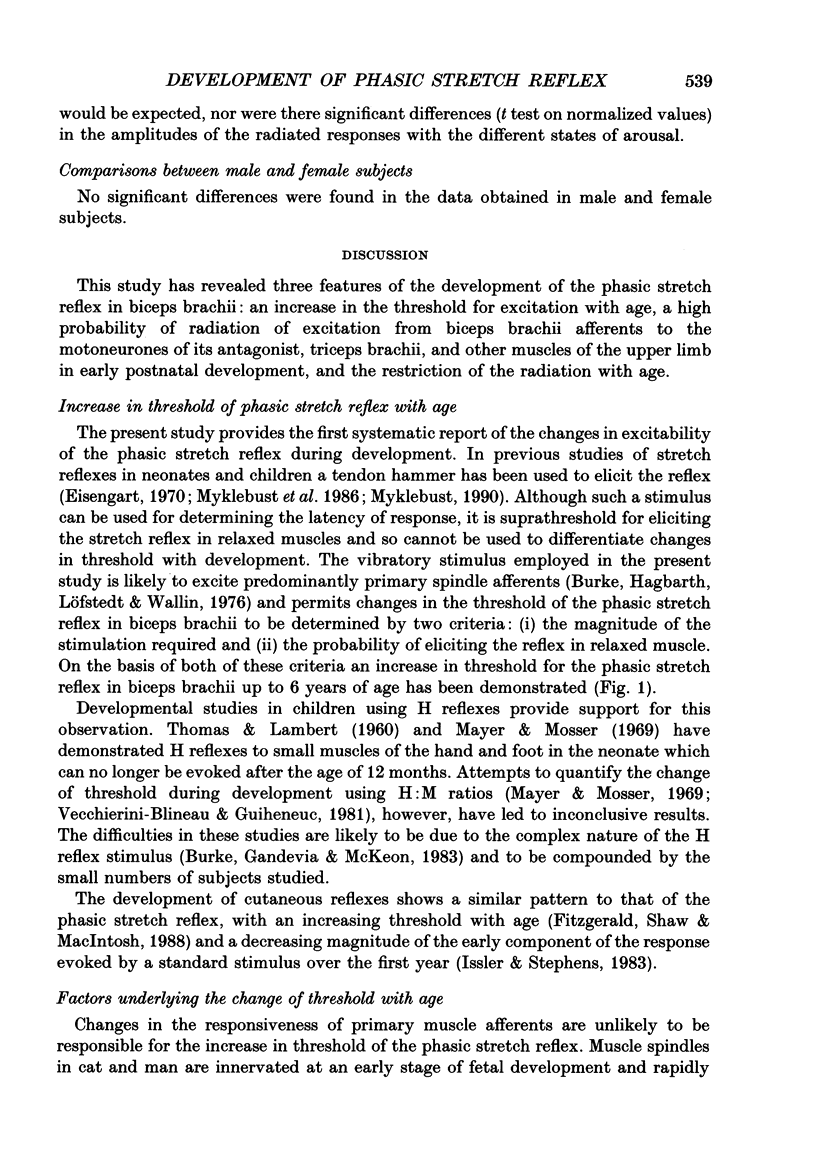

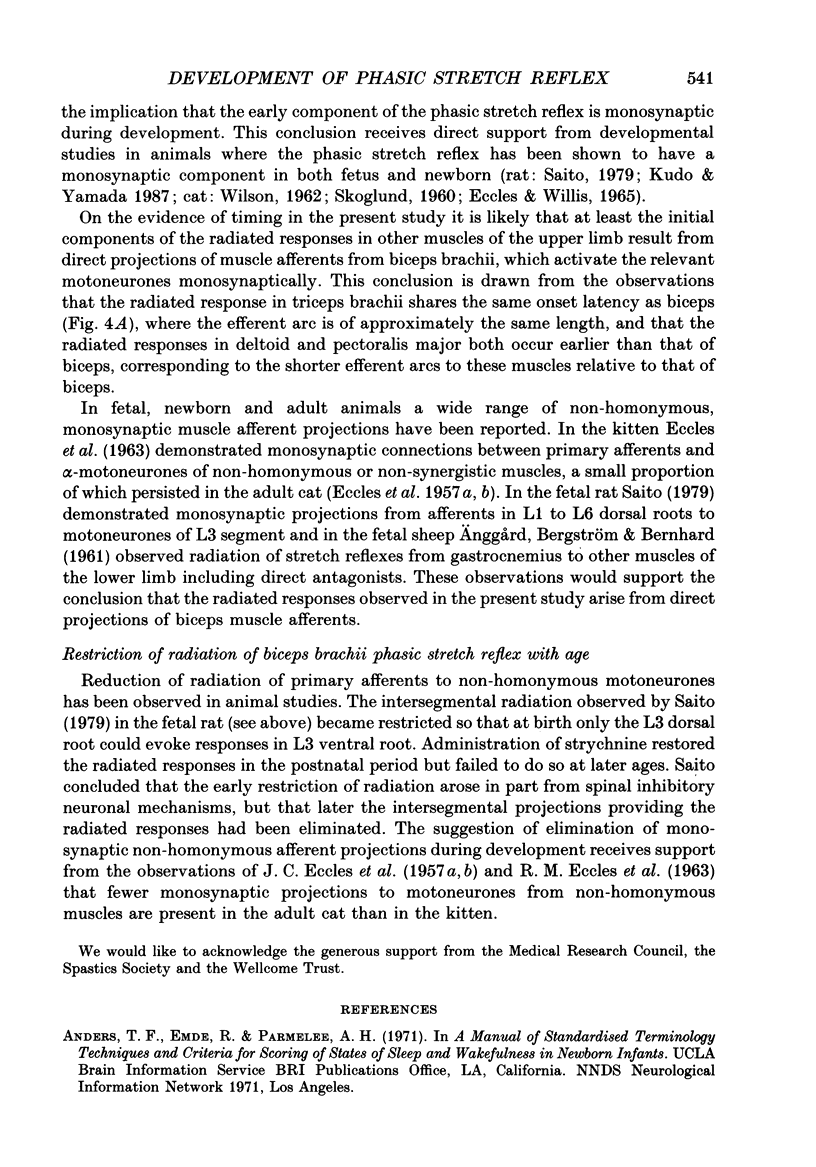
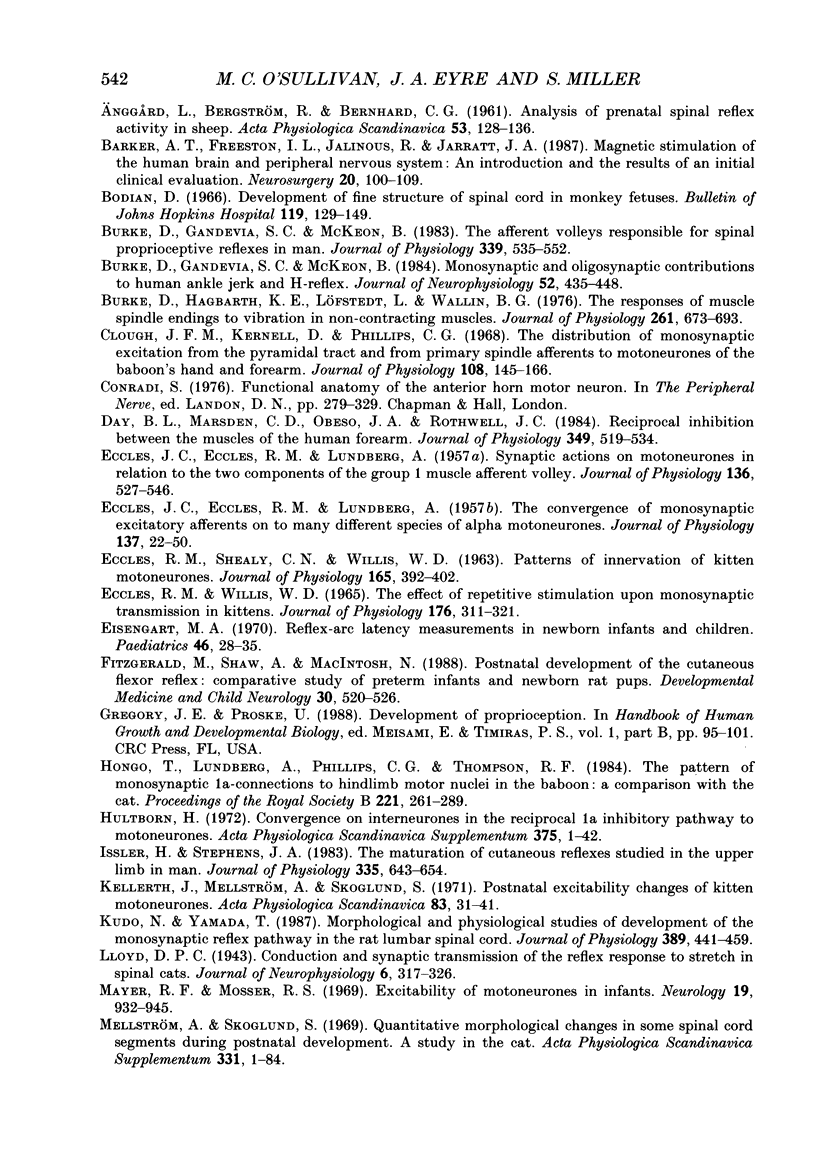
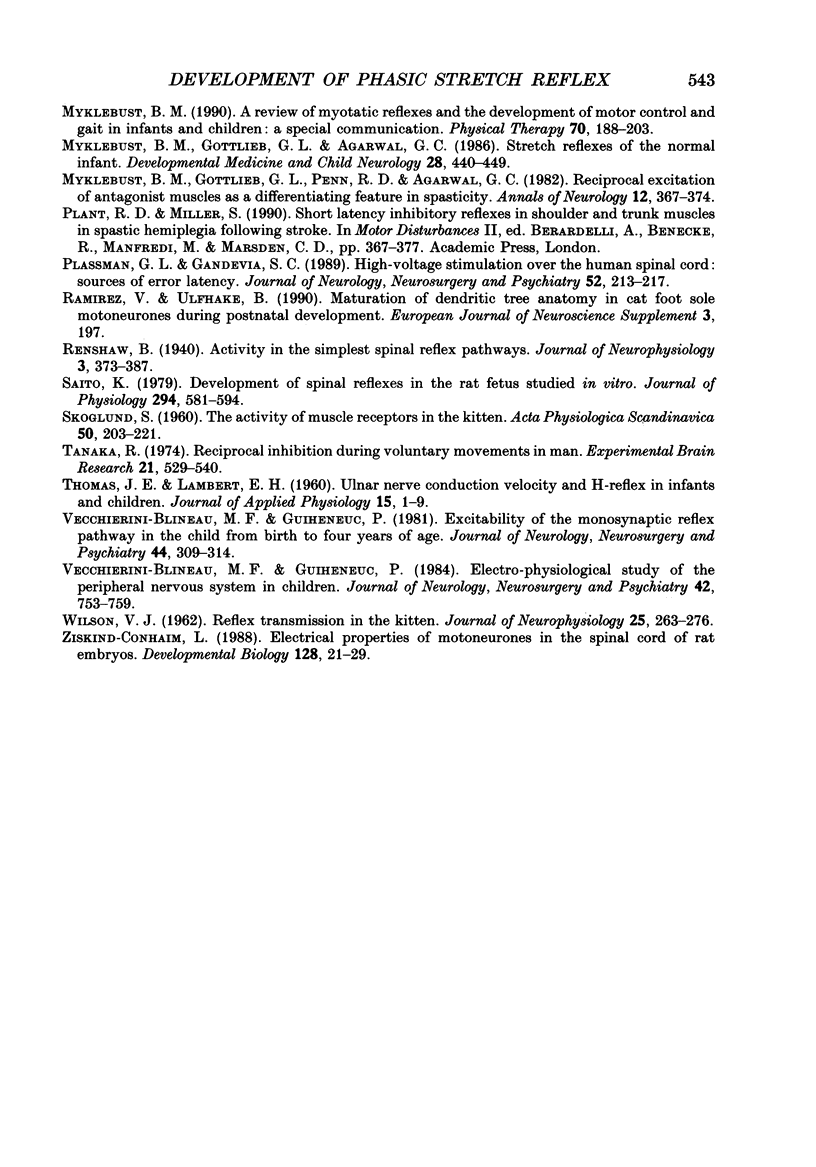
Selected References
These references are in PubMed. This may not be the complete list of references from this article.
- ANGGARD L., BERGSTROM R., BERNHARD C. G. Analysis of prenatal spinal reflex activity in sheep. Acta Physiol Scand. 1961 Oct;53:128–136. doi: 10.1111/j.1748-1716.1961.tb02270.x. [DOI] [PubMed] [Google Scholar]
- Barker A. T., Freeston I. L., Jalinous R., Jarratt J. A. Magnetic stimulation of the human brain and peripheral nervous system: an introduction and the results of an initial clinical evaluation. Neurosurgery. 1987 Jan;20(1):100–109. doi: 10.1097/00006123-198701000-00024. [DOI] [PubMed] [Google Scholar]
- Burke D., Gandevia S. C., McKeon B. Monosynaptic and oligosynaptic contributions to human ankle jerk and H-reflex. J Neurophysiol. 1984 Sep;52(3):435–448. doi: 10.1152/jn.1984.52.3.435. [DOI] [PubMed] [Google Scholar]
- Burke D., Gandevia S. C., McKeon B. The afferent volleys responsible for spinal proprioceptive reflexes in man. J Physiol. 1983 Jun;339:535–552. doi: 10.1113/jphysiol.1983.sp014732. [DOI] [PMC free article] [PubMed] [Google Scholar]
- Burke D., Hagbarth K. E., Löfstedt L., Wallin B. G. The responses of human muscle spindle endings to vibration of non-contracting muscles. J Physiol. 1976 Oct;261(3):673–693. doi: 10.1113/jphysiol.1976.sp011580. [DOI] [PMC free article] [PubMed] [Google Scholar]
- Clough J. F., Kernell D., Phillips C. G. The distribution of monosynaptic excitation from the pyramidal tract and from primary spindle afferents to motoneurones of the baboon's hand and forearm. J Physiol. 1968 Sep;198(1):145–166. doi: 10.1113/jphysiol.1968.sp008598. [DOI] [PMC free article] [PubMed] [Google Scholar]
- Day B. L., Marsden C. D., Obeso J. A., Rothwell J. C. Reciprocal inhibition between the muscles of the human forearm. J Physiol. 1984 Apr;349:519–534. doi: 10.1113/jphysiol.1984.sp015171. [DOI] [PMC free article] [PubMed] [Google Scholar]
- ECCLES J. C., ECCLES R. M., LUNDBERG A. Synaptic actions on motoneurones in relation to the two components of the group I muscle afferent volley. J Physiol. 1957 May 23;136(3):527–546. doi: 10.1113/jphysiol.1957.sp005778. [DOI] [PMC free article] [PubMed] [Google Scholar]
- ECCLES J. C., ECCLES R. M., LUNDBERG A. The convergence of monosynaptic excitatory afferents on to many different species of alpha motoneurones. J Physiol. 1957 Jun 18;137(1):22–50. doi: 10.1113/jphysiol.1957.sp005794. [DOI] [PMC free article] [PubMed] [Google Scholar]
- ECCLES R. M., WILLIS W. D. THE EFFECT OF REPETITIVE STIMULATION UPON MONOSYNAPTIC TRANSMISSION IN KITTENS. J Physiol. 1965 Jan;176:311–321. doi: 10.1113/jphysiol.1965.sp007552. [DOI] [PMC free article] [PubMed] [Google Scholar]
- Eccles R. M., Shealy C. N., Willis W. D. Patterns of innervation of kitten motoneurones. J Physiol. 1963 Mar;165(3):392–402. doi: 10.1113/jphysiol.1963.sp007065. [DOI] [PMC free article] [PubMed] [Google Scholar]
- Eisengart M. A. Reflex-arc latency measurements in newborn infants and children. Pediatrics. 1970 Jul;46(1):28–35. [PubMed] [Google Scholar]
- Fitzgerald M., Shaw A., MacIntosh N. Postnatal development of the cutaneous flexor reflex: comparative study of preterm infants and newborn rat pups. Dev Med Child Neurol. 1988 Aug;30(4):520–526. doi: 10.1111/j.1469-8749.1988.tb04779.x. [DOI] [PubMed] [Google Scholar]
- Hongo T., Lundberg A., Phillips C. G., Thompson R. F. The pattern of monosynaptic Ia-connections to hindlimb motor nuclei in the baboon: a comparison with the cat. Proc R Soc Lond B Biol Sci. 1984 May 22;221(1224):261–289. doi: 10.1098/rspb.1984.0034. [DOI] [PubMed] [Google Scholar]
- Hultborn H. Convergence on interneurones in the reciprocal Ia inhibitory pathway to motoneurones. Acta Physiol Scand Suppl. 1972;375:1–42. doi: 10.1111/j.1748-1716.1972.tb05298.x. [DOI] [PubMed] [Google Scholar]
- Issler H., Stephens J. A. The maturation of cutaneous reflexes studied in the upper limb in man. J Physiol. 1983 Feb;335:643–654. doi: 10.1113/jphysiol.1983.sp014556. [DOI] [PMC free article] [PubMed] [Google Scholar]
- Kellerth J. O., Mellström A., Skoglund S. Postnatal excitability changes of kitten motoneurones. Acta Physiol Scand. 1971 Sep;83(1):31–41. doi: 10.1111/j.1748-1716.1971.tb05048.x. [DOI] [PubMed] [Google Scholar]
- Kudo N., Yamada T. Morphological and physiological studies of development of the monosynaptic reflex pathway in the rat lumbar spinal cord. J Physiol. 1987 Aug;389:441–459. doi: 10.1113/jphysiol.1987.sp016665. [DOI] [PMC free article] [PubMed] [Google Scholar]
- Mayer R. F., Mosser R. S. Excitability of motoneurons in infants. Neurology. 1969 Oct;19(10):932–945. doi: 10.1212/wnl.19.10.932. [DOI] [PubMed] [Google Scholar]
- Mellström A., Skoglund S. Quantitative morphological changes in some spinal cord segments during postnatal development. A study in the cat. Acta Physiol Scand Suppl. 1969;331:1–84. [PubMed] [Google Scholar]
- Myklebust B. M. A review of myotatic reflexes and the development of motor control and gait in infants and children: a special communication. Phys Ther. 1990 Mar;70(3):188–203. doi: 10.1093/ptj/70.3.188. [DOI] [PubMed] [Google Scholar]
- Myklebust B. M., Gottlieb G. L., Agarwal G. C. Stretch reflexes of the normal infant. Dev Med Child Neurol. 1986 Aug;28(4):440–449. doi: 10.1111/j.1469-8749.1986.tb14281.x. [DOI] [PubMed] [Google Scholar]
- Myklebust B. M., Gottlieb G. L., Penn R. D., Agarwal G. C. Reciprocal excitation of antagonistic muscles as a differentiating feature in spasticity. Ann Neurol. 1982 Oct;12(4):367–374. doi: 10.1002/ana.410120409. [DOI] [PubMed] [Google Scholar]
- Plassman B. L., Gandevia S. C. High-voltage stimulation over the human spinal cord: sources of latency variation. J Neurol Neurosurg Psychiatry. 1989 Feb;52(2):213–217. doi: 10.1136/jnnp.52.2.213. [DOI] [PMC free article] [PubMed] [Google Scholar]
- Saito K. Development of spinal reflexes in the rat fetus studied in vitro. J Physiol. 1979 Sep;294:581–594. doi: 10.1113/jphysiol.1979.sp012947. [DOI] [PMC free article] [PubMed] [Google Scholar]
- THOMAS J. E., LAMBERT E. H. Ulnar nerve conduction velocity and H-reflex in infants and children. J Appl Physiol. 1960 Jan;15:1–9. doi: 10.1152/jappl.1960.15.1.1. [DOI] [PubMed] [Google Scholar]
- Tanaka R. Reciprocal Ia inhibition during voluntary movements in man. Exp Brain Res. 1974;21(5):529–540. doi: 10.1007/BF00237171. [DOI] [PubMed] [Google Scholar]
- Vecchierini-Blineau M. F., Guiheneuc P. Electrophysiological study of the peripheral nervous system in children. Changes in proximal and distal conduction velocities from birth to age 5 years. J Neurol Neurosurg Psychiatry. 1979 Aug;42(8):753–759. doi: 10.1136/jnnp.42.8.753. [DOI] [PMC free article] [PubMed] [Google Scholar]
- Vecchierini-Blineau M. F., Guiheneuc P. Excitability of the monosynaptic reflex pathway in the child from birth to four years of age. J Neurol Neurosurg Psychiatry. 1981 Apr;44(4):309–314. doi: 10.1136/jnnp.44.4.309. [DOI] [PMC free article] [PubMed] [Google Scholar]
- WILSON V. J. Reflex transmission in the kitten. J Neurophysiol. 1962 Mar;25:263–276. doi: 10.1152/jn.1962.25.2.263. [DOI] [PubMed] [Google Scholar]
- Ziskind-Conhaim L. Electrical properties of motoneurons in the spinal cord of rat embryos. Dev Biol. 1988 Jul;128(1):21–29. doi: 10.1016/0012-1606(88)90262-x. [DOI] [PubMed] [Google Scholar]


